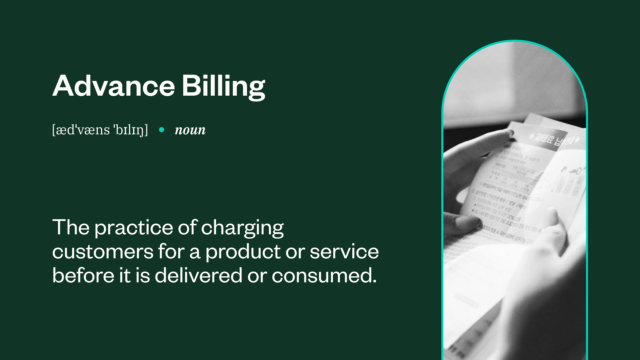Glossary Hub / Advance billing: What it is and how it helps your business
Advance billing: What it is and how it helps your business

Are you looking to enhance cash flow, customer loyalty, and revenue predictability? Advance billing can help with all of this and more.
Perhaps you’ve heard of advance billing, but want to learn more about it. In this article, we’ll cover what advance billing is, when and why it’s used, how it works for subscription businesses, advantages and disadvantages, best practices, and how to overcome common challenges.
What is advance billing?
Advance billing, also known as pre-billing or upfront billing, is the business practice of charging customers for a product or service before it has been delivered or consumed. This proactive approach to revenue collection is common across numerous industries.

Some examples of this are:
Annual software subscriptions: This could include photo editing software, digital document tools, billing software, and more.
Membership or club fees: Gyms, warehouse stores such as Costco where you can buy in bulk, university alumni associations, and other membership services have advance billing options.
Maintenance packages: This could include car service and maintenance plans that cover oil changes or tire rotations, managed IT services that aid cybersecurity needs, or lawn care services.
When and why advance billing is used
Advance billing can help your business gain financial confidence and customer commitment, but you need to know when and why it’s used.
Let’s look at some examples of when you might want to consider billing in advance:
Seasonal or limited-time services: Advanced billing can be a great way to take stress off of customers and help your business get paid sooner. Examples include concerts, summer camps, or annual events.
High-demand or high-cost items: To avoid non-payment, protect against fraud, and ensure product availability, products that are in high demand or more expensive may benefit from advance billing. For example, premium software solutions that require significant setup.
Predictable and regular usage: Businesses may want to use advance billing for recurring services where usage is consistent or easily forecast. This could include offerings such as streaming services, cloud storage services, or rental agreements.
Here are some reasons why you might want to implement advance pricing for your services:
Immediate cash flow: Your company can reinvest revenue sooner and ensure a consistent income stream to cover business expenses.
Customer commitment: A larger upfront investment encourages longer term engagement and loyalty. And, your business can offer a special discount to customers who pay more upfront, creating a sense of exclusivity for the customer and satisfaction with greater savings.
Efficiency in forecasting: Advance billing helps with financial planning and resource allocation. Your business can scale efficiently with the prepaid demand to move it forward.
Advance billing for subscription businesses
In the modern economy, subscriptions mean predictable revenue, making advance billing a natural fit.
Advance billing delivers compelling advantages for subscription businesses, such as:
Less churn: Automatic annual or quarterly prepayment can maintain retention and reduce cancellation rates or non-payment.
Improve customer relationships: Advance billing builds trust when the service consistently meets expectations. When customers feel like they are valued and getting a better deal on a service, they’re more likely to continue purchasing and to recommend the service to others.
Bundled offers: Companies can package together services like premium support or additional features as an incentive for paying upfront, boosting business revenue and customer satisfaction.
When implementing advance billing options into your business strategy, transparency is key. Communicate the billing cycle, renewal date, and cancellation policy upfront to avoid confusion down the road. As your subscription base grows, an automated system is crucial to handling complex billing scenarios.
To maximize efficiency and minimize errors, invest in a billing management system that automates the invoicing and billing process, supports multiple pricing models, and integrates with your various operational and financial systems while ensuring compliance with industry standards.
Advantages and disadvantages of billing in advance
Billing in advance is an effective way to boost revenue, maintain steady financial operations, and give customers a sense of value. Whether you use an enterprise billing model or operate as an SMB, there are some pros and cons to be aware of before providing an advance billing option.
Advantages
Immediate working capital: With more money upfront, you can more quickly cover the cost of labor, inventory management, and software needs.
Stronger customer loyalty and commitment: Paying for a service upfront encourages customers to stay with your company for the duration of their payment period.
Simplified logistics: Earlier payments make it easier to manage billing cycles for large customer bases.
Disadvantages
Perception of higher upfront cost: Some customers may be hesitant to pay a seemingly larger amount of money initially, especially if they are new to the service.
Risk of refunds or disputes: If service expectations aren’t met, customers may request refunds of refute charges. This can lead to costly chargebacks, hurt financial stability, and result in poor company reviews.
Compliance and taxation complexities: Advance payments can affect revenue recognition rules. Until a product or service is delivered, advance payments are noted as unearned revenue. The unearned revenue is recognized as a liability in many jurisdictions, requiring sophisticated accounting practices and potentially specialized expertise to ensure proper financial reporting.
Best practices for implementing advance billing
With increased cash flow and customer satisfaction, your business can continue to scale. But you need to make sure you’re following advance billing best practices to operate effectively. Consider the following to ensure customers and internal team members are on the same page:
Clear communication
Prioritize transparency by prominently sharing the terms and conditions with the customer before the start of service so they can review them and come to you with any questions if necessary. Ensure a notification is sent when it’s time for the customer to renew their service so they can plan accordingly and not be caught off guard when a large payment is due. Outline refund or cancellation policies upfront to avoid any confusion or frustration later on.
Tiered pricing models
Your business can attract more customers and boost revenue by offering various pricing options. Providing different pricing models gives customers more options to choose from to find one that best suits their needs and budget. Tiered pricing models can include monthly, quarterly, and annual plans. This encourages customers to stick around for the long haul, and by offering them discounts along the way, you can improve customer loyalty.
Automated billing systems
Automating your invoicing and billing process reduces the amount of manual intervention needed and the number of human errors made. Automated billing systems can improve tracking and reporting efficiency. With a set of predefined rules, your billing system will automatically install late fees or discounts. Your teams can focus on strategic work and relationship building rather than repetitive tasks. For tips on choosing a billing software solution that fits your business needs, check out our billing software buyer’s guide.
Legal and tax compliance
Until a service is delivered, an advance payment is considered a liability in many jurisdictions. Businesses must abide by the generally accepted accounting principles (GAAP) or international financial reporting standards (IFRS) to accurately recognize revenue. Stay in the know with local tax and other financial regulations. In some instances, you may opt to do billing in arrears, or invoice after a product or service is delivered.
Common challenges and how to overcome them
With any change, especially when it comes to finances, both customers and internal teams may feel uncertain. By being transparent and sharing any updates to service as soon as you have them, your teams and customers can feel at ease.
Here are some common challenges related to advance billing and ways you can overcome them:
Customer pushback: Change can be difficult. Especially for a newer customer who isn’t as familiar with the services offered. A larger upfront payment can cause hesitation and resistance.
Solution: Offer trial periods, smaller upfront deposits, or flexible billing cycles.
Revenue recognition complexity: Revenue cannot be properly recognized until a service is delivered. It’s imperative to accurately recognize revenue — otherwise, your business risks legal issues.
Solution: Implement accounting software or consult with finance teams to handle deferred revenue correctly.
High cancellation rates: Customers may cancel due to inaccurate service delivery timelines, dissatisfaction, or other reasons.
Solution: Provide continuous value, regular communication, and easy plan modifications.
How Zuora Billing can advance your business
Billing in advance can improve cash flow, help to better predict revenue, and create stronger customer relationships. Adding advance billing options to your business process is simpler than you might think. A Zuora Billing solution takes the load off your team with end-to-end automation for advance billing cycles, reducing manual errors, and it can manage multiple billing frequencies and pricing tiers, offering a personalized experience for customers. The software has built-in tools to help ensure compliance with revenue recognition and tax regulations.
Zuora Billing also provides real-time analytics, giving your teams access to detailed dashboards and reporting tools to monitor churn, revenue growth, and other key metrics. As your business grows, the software grows with it as a scalable, adaptable platform made to handle increased billing volumes, complex product bundles, and global expansion. With centralized payment methods, self-service portals, and automated renewals to foster stronger customer loyalty, you’ll be exceeding your business goals and delivering greater customer success in no time.
Check out Zuora Billing today and talk with one of our experts to learn more.


